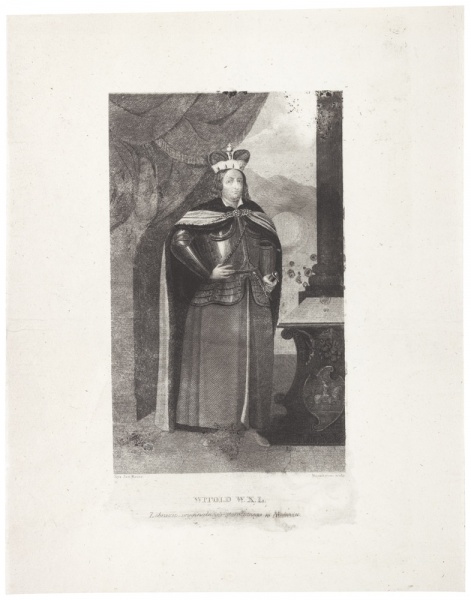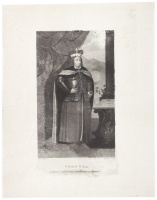
Grand Duke Vytautas of Lithuania
| Author: |
W. Wrankmore |
| Created: | 1841 |
| Material: | paper |
| Technique: | etching |
| Dimensions: | 23 × 15 cm |
| Signature: | bottom left: Rys. Jan Hesse bottom right: Wrankmore sculp |
KRASZEWSKI JÓZEF IGNACY, WILNO OD POCZĄTKÓW JEGO DO ROKU 1750, T. 1–4, WILNO, 1840–1842.
Etching after Jan Hesse.
The interest in 19th-century Lithuania in Grand Duke Vytautas (ca. 1350–1430) grew along with the general movement towards exploring the history of the homeland. As early as 1821, Antoni Bolesław Hlebowicz (1801–1847), a philosophy candidate in the Faculty of Literature and Fine Arts at Vilnius University, published Krótki rys życia Witołda W. X. Litewskiego (A Short Life of Vytautas, Grand Duke of Lithuania) at A. Marcinowski’s printing press. One of his most famous prints was published in the first half of the 19th century by Adam Zawadzki’s press in Vilnius. This portrait is a copy of an imaginary likeness painted in the 18th century and kept in the Radziwiłł (Radvila) portrait gallery at Nesvizh. The portrait was redrawn in Nesvizh by Jan Hesse (ca. 1807–1870), a student at the Vilnius School of Art, and engraved by the English engraver William Wrankmore (mentioned between 1836 and 1858?). The portrait was bound as an illustration in the second volume of ‘Vilnius: From its Founding up to the Year 1750’ by Józef Ignacy Kraszewski, which was republished in 1841. Another version of the portrait is a lithograph by Józef Oziębłowski made in 1841. This image, engraved from a painted portrait, shows Vytautas the Great as a great ruler and military leader, in compliance with the emerging myth of him and subsequently serving as a model for numerous portraits.
Text author Rūta Janonienė
Source: Law firm Valiunas Ellex art album RES PUBLICA (2018). Compiler and author Rūta Janonienė






